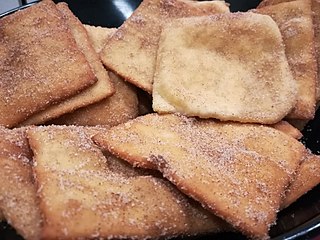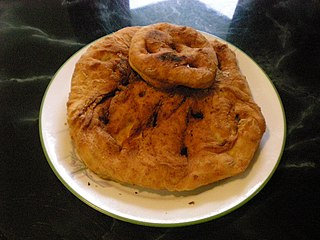
A taco is a traditional Mexican food consisting of a small hand-sized corn- or wheat-based tortilla topped with a filling. The tortilla is then folded around the filling and eaten by hand. A taco can be made with a variety of fillings, including beef, pork, chicken, seafood, beans, vegetables, and cheese, and garnished with various condiments, such as salsa, guacamole, or sour cream, and vegetables, such as lettuce, onion, tomatoes, and chiles. Tacos are a common form of antojitos, or Mexican street food, which have spread around the world.

In North America, a corn tortilla or just tortilla is a type of thin, unleavened flatbread, made from hominy, that is the whole kernels of maize treated with alkali to improve their nutrition in a process called nixtamalization. A simple dough made of ground, dried hominy, salt and water is then formed into flat discs and cooked on a very hot surface, generally an iron griddle called a comal.

Cornbread is a quick bread made with cornmeal, associated with the cuisine of the Southern United States, with origins in Native American cuisine. It is an example of batter bread. Dumplings and pancakes made with finely ground cornmeal are staple foods of the Hopi people in Arizona. The Hidatsa people of the Upper Midwest call baked cornbread naktsi. Cherokee and Seneca tribes enrich the basic batter, adding chestnuts, sunflower seeds, apples, or berries, and sometimes combine it with beans or potatoes. Modern versions of cornbread are usually leavened by baking powder.

A sopaipilla, sopapilla, sopaipa, or cachanga is a kind of fried pastry and a type of quick bread served in several regions with Spanish heritage in the Americas. The word sopaipilla is the diminutive of sopaipa, a word that entered Spanish from the Mozarabic language of Al-Andalus. The original Mozarabic word Xopaipa was used to mean bread soaked in oil. The word is derived in turn from the Germanic word suppa, which meant bread soaked in liquid.

The ensaïmada is a pastry product from Mallorca, Balearic Islands, Spain. It is a common cuisine eaten in southwestern Europe, Latin America and the Philippines.

A hush puppy is a small, savory, deep-fried round ball made from cornmeal-based batter. Hushpuppies are frequently served as a side dish with seafood and other deep-fried foods.

New Mexican cuisine is the cuisine of the Southwestern US state of New Mexico. The region is primarily known for its fusion of Pueblo Native American cuisine with Hispano Spanish and Mexican cuisine originating in Nuevo México.

A flatbread is bread made usually with flour; water, milk, yogurt, or other liquid; and salt, and then thoroughly rolled into flattened dough. Many flatbreads are unleavened, although some are leavened, such as pita bread.

Lángos is a typical Hungarian food. Nowadays it is a deep fried flatbread, but in the past it was made of the last bits of the bread-dough and baked at the front of a brick or clay oven, to be served hot as the breakfast of the bread-baking day.

Mexican street food, called antojitos, is prepared by street vendors and at small traditional markets in Mexico. Street foods include tacos, tamales, gorditas, quesadillas, empalmes, tostadas, chalupa, elote, tlayudas, cemita, pambazo, empanada, nachos, chilaquiles, fajita tortas, even hamburgers and hot dogs, as well as fresh fruits, vegetables, beverages and soups such as menudo, pozole and pancita. Most are available in the morning and the evening, as mid-afternoon is the time for the main formal meal of the day. Mexico has one of the most extensive street food cultures in Latin America, and Forbes named Mexico City as one of the foremost cities in the world in which to eat on the street.

Boortsog or bawïrsaq is a type of fried dough food found in the cuisines of Central Asia, Idel-Ural, Mongolia and the Middle East. It is shaped into either triangles or sometimes spheres. The dough consists of flour, yeast, milk, eggs, butter, salt, sugar, and margarine. Tajik boortsog are often decorated with a criss-cross pattern by pressing the bottom of a small strainer on the dough before it is fried.

A flour tortilla or wheat tortilla is a type of soft, thin flatbread made from finely ground wheat flour. Made with flour- and water-based dough, it is pressed and cooked, similar to corn tortillas. The simplest recipes use only flour, water, fat, and salt, but commercially-made flour tortillas generally contain chemical leavening agents such as baking powder, and other ingredients.
The Fry Bread House is a restaurant in Phoenix, Arizona, serving fry bread, a Native American dish of dough fried in lard, Crisco, or oil, which the restaurant serves with various toppings or fillings. Exact recipes and ingredients vary but those typical of frybread are flour, salt, and lard, reflecting the commodities doled out on the reservations by the U.S. federal government.

The gnocco fritto or crescentina is a bread in Italian cuisine from the Emilia region of Italy, prepared using flour, water and lard as primary ingredients. Cracklings are sometimes used in its preparation as well. In Emilia-Romagna, it is typically sliced into diamond shapes and then fried, and may be accompanied with cheese and salumi. When it is fried, the bread puffs up, and it may include yeast or baking soda to leaven it. Versions prepared with milk are softer than those prepared with water. It may be served either as an appetizer or as a main dish. Despite the name by which in Italy it is often referred to as a kind of gnocchi, it is technically not.
More Than Frybread is a comedic pseudo-documentary that was released in 2012 which was directed and written by Travis Holt Hamilton. The 96-minute comedy premiered at the Harkins Valley Art Center on May 4, 2012. This film stars Tatanka Means, Greg Fernanadez and Mary Kim Titla. Wanting to celebrate and showcase Native cultural tradition, Hamilton says “More Than Frybread is a comedy to showcase nationalism and inter-tribal competition”

The Sioux Chef's Indigenous Kitchen is a recipe book written by Sean Sherman with Beth Dooley, published by the University of Minnesota Press in Minneapolis, Minnesota. Sean Sherman is an Oglala Lakota chef who was born in Pine Ridge, South Dakota, and is currently based in South Minneapolis. Sherman opened an Indigenous cuisine restaurant within the Water Works park development project overlooking Saint Anthony Falls and the Stone Arch Bridge in Minneapolis in 2021.

Sean Sherman is an Oglala Lakota Sioux chef, cookbook author, forager, and promoter of indigenous cuisine. Sherman founded the indigenous food education business and caterer The Sioux Chef and cofounded with then-partner Dana Thompson the nonprofit North American Traditional Indigenous Food Systems (NĀTIFS). He received a James Beard Foundation Leadership Award and his 2017 cookbook, The Sioux Chef's Indigenous Kitchen, won the 2018 James Beard Award for Best American Cookbook. In 2022 the restaurant he co-owned with Thompson, Owamni, won the James Beard Award for Best New Restaurant.

Lois Ellen Frank is an American food historian, cookbook author, culinary anthropologist, and educator. She won a 2003 James Beard Foundation Award for her cookbook Foods of the Southwest Indian Nations, the first cookbook of Native American cuisine so honored.

Bannock, skaan, Indian bread, alatiq, or frybread is found throughout North-American Native cuisine, including that of the Inuit of Canada and Alaska, other Alaska Natives, the First Nations of the rest of Canada, the Native Americans in the United States, and the Métis.























